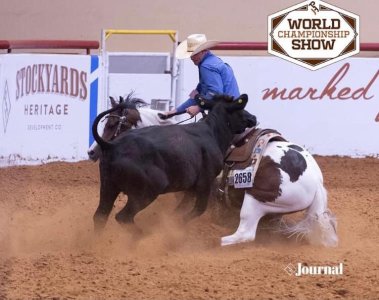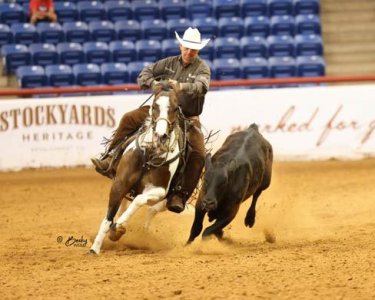You are aware if a Holstein steer is over 50% black and grades he can bring CAB premium for the carcass?Maybe, but you have to agree that there's never been a push for the black premium like this from a well funded program and the influence of it is apparent everywhere.
Just look at what has happened and it wasn't overnight.
The sims in the 70's and 80's sure weren't very black, nor were the Lims
The RA's even though it is supposedly a colored version of the angus breed isn't getting the premium like the blacks do either.
TRends change markets of all products for long periods of time and some time seem almost irreversible.
So the question is, knowing the trends, if a black calf and a red calf walk into the ring and the black calf continually brings more (the reason doesn't matter), why would you go out of the way to produce another color if it takes the same input and effort unless you are trying to make a statement.
And if the statement is
"I'm ok with working as hard to produce a product that I know won't bring as much as another product which has the same production costs, and I willingly and knowingly understand I am throwing profits out the window"
And you believe that's a good thing, go ahead and do it, that's the good part about our country, you are free to choose to do whatever you want as long as you can bear the costs.
You just really can't blame others for your loss when you do and you can't complain about "fair" .
You are using an out of date browser. It may not display this or other websites correctly.
You should upgrade or use an alternative browser.
You should upgrade or use an alternative browser.
Stirring the pot on the LH/corriente topic
- Thread starter BFE
- Start date

Help Support CattleToday:
On the subject of covering the "little spots" like the LH cow in the post by @crossbreed . You find this pattern the most in LHs. Not so much in pure Corriente. Corrs wil have more of a "paint" pattern. Much like the Herf/Hol @MurraysMutts has. Or the Herf/Guresney I have. Most Corrs that aren't a shade of brown/tan. or black, or white, will look like those. Corss can have a coat that looks like a red-faced Hereford, or like the red & white Simms had, or a Guernsey, or Holstein. Usually when the little spots get in them, they have had some LH blood infused in them somewhere. None of our Mexican Corrs were "roan", but the ones we had that were, were US cattle. A lot of people would cross the Corrs with LH for faster, bigger bull dogging steers. Booger Barter would use them as "prize steers" in his competitions.
The first cattle the Spaniards brought, were most likely solid colored. As they dispersed, we saw that those along the southern coast....Fla, Ala, Miss, LA, etc... tended to evolve horns that grew narrow and up, rather than wide and long, like the LHs. As these cattle dispersed across the nation, and as pioneers settled across the west, they brought their milk cows with them, including Shorthorn and Ayrshires....both of which display a lot of roan-ing coats. And that is how that color got into the wild Longhorns. Fla Scrubs and Crackers, and Pineywoods cattle.. Corriente, not so much. Not saying there are NO Corrs with the "little spots", just not so prevalent as in LHs.
I have talked about Clay's boss who feeds out 900-1000 1/2 Brangus each year, He has 400 cows of his own, probably 390 of them pure Corr. He will use about 395 average a year in his program. He also provides bulls to several out fits in Florida which have mostly Fla Scrub/Cracker, and buys the calves at 6 mos old. He buys about 600 a year, and often only 500-550 go into his program. He only uses the solid black and polled calves for his deal where he sends them to the Oklahoma feed lot. Sometimes you might see one or two in his feed lots with a white star. We had one LH/Watusi cross, that often produced a black, but scurred calf. Hard to overcome that African Horn gene. And we had a Pineywoods cow, that was black with white roan-ing on her belly and up on her flank a little. A lot of her calves had that too, just not as much as she did. Everything else we had, from 100-120 a year, was polled and black, using the bulls we do, and 90% of the cows being Corr.
The first cattle the Spaniards brought, were most likely solid colored. As they dispersed, we saw that those along the southern coast....Fla, Ala, Miss, LA, etc... tended to evolve horns that grew narrow and up, rather than wide and long, like the LHs. As these cattle dispersed across the nation, and as pioneers settled across the west, they brought their milk cows with them, including Shorthorn and Ayrshires....both of which display a lot of roan-ing coats. And that is how that color got into the wild Longhorns. Fla Scrubs and Crackers, and Pineywoods cattle.. Corriente, not so much. Not saying there are NO Corrs with the "little spots", just not so prevalent as in LHs.
I have talked about Clay's boss who feeds out 900-1000 1/2 Brangus each year, He has 400 cows of his own, probably 390 of them pure Corr. He will use about 395 average a year in his program. He also provides bulls to several out fits in Florida which have mostly Fla Scrub/Cracker, and buys the calves at 6 mos old. He buys about 600 a year, and often only 500-550 go into his program. He only uses the solid black and polled calves for his deal where he sends them to the Oklahoma feed lot. Sometimes you might see one or two in his feed lots with a white star. We had one LH/Watusi cross, that often produced a black, but scurred calf. Hard to overcome that African Horn gene. And we had a Pineywoods cow, that was black with white roan-ing on her belly and up on her flank a little. A lot of her calves had that too, just not as much as she did. Everything else we had, from 100-120 a year, was polled and black, using the bulls we do, and 90% of the cows being Corr.
What kind of bull?I had just a couple that were not solid, here is a red, bred to same bull in consecutive years with different results. Will drive you nuts LOLView attachment 39080
Nope. Read the 10 requirements of the CAB program.You are aware if a Holstein steer is over 50% black and grades he can bring CAB premium for the carcass?
Stickney94
Well-known member
Nope. Read the 10 requirements of the CAB program.
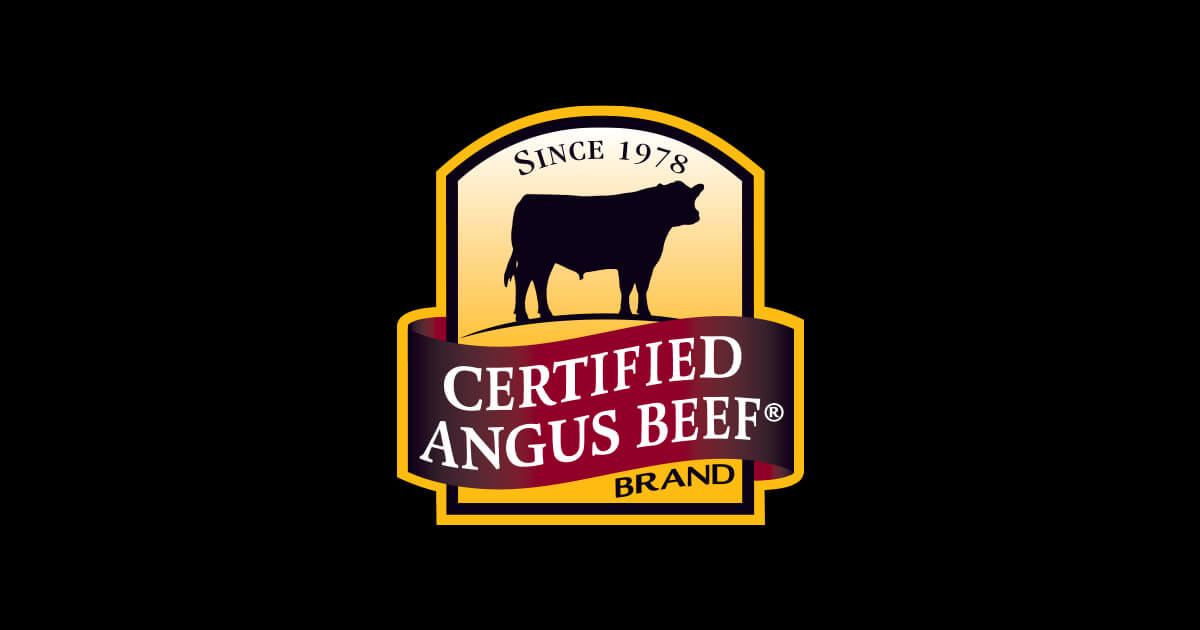
Certified Angus Beef® brand | 10 Specifications
Our 10 Specifications for Quality
www.certifiedangusbeef.com
OR here: https://www.angus.org/Pub/FAQs -- below
8.What are the requirements for the Certified Angus Beef® (CAB) brand?
Live cattle must be Angus-influenced: have a predominately (51%) solid black hide to be eligible for CAB evaluation. They must meet all of the 10 following criteria to be certified by USDA graders and labeled with the Certified Angus Beef® brand:
- Modest or higher marbling
- Medium to fine marbling texture
- "A" maturity (both lean & skeletal)
- 10- to 16-square-inch ribeye area
- 1,050 pounds hot carcass weight or less
- 1-inch or less fat thickness
- Superior muscling (limits light-muscled cattle)
- Practically free of capillary rupture
- No dark cutters
- No neck hump exceeding 2 inches
mwj
Well-known member

Certified Angus Beef® brand | 10 Specifications
Our 10 Specifications for Qualitywww.certifiedangusbeef.com
OR here: https://www.angus.org/Pub/FAQs -- below
8.What are the requirements for the Certified Angus Beef® (CAB) brand?
Live cattle must be Angus-influenced: have a predominately (51%) solid black hide to be eligible for CAB evaluation. They must meet all of the 10 following criteria to be certified by USDA graders and labeled with the Certified Angus Beef® brand:
- Modest or higher marbling
- Medium to fine marbling texture
- "A" maturity (both lean & skeletal)
- 10- to 16-square-inch ribeye area
- 1,050 pounds hot carcass weight or less
- 1-inch or less fat thickness
- Superior muscling (limits light-muscled cattle)
- Practically free of capillary rupture
- No dark cutters
- No neck hump exceeding 2 inches
Read the specs and it will specify where the white can be located.
Yep! Having the black hide and Angus in fluence is the requirements to even see if they meet the other 10 requirements!
Certified Angus Beef® brand | 10 Specifications
Our 10 Specifications for Qualitywww.certifiedangusbeef.com
OR here: https://www.angus.org/Pub/FAQs -- below
8.What are the requirements for the Certified Angus Beef® (CAB) brand?
Live cattle must be Angus-influenced: have a predominately (51%) solid black hide to be eligible for CAB evaluation. They must meet all of the 10 following criteria to be certified by USDA graders and labeled with the Certified Angus Beef® brand:
- Modest or higher marbling
- Medium to fine marbling texture
- "A" maturity (both lean & skeletal)
- 10- to 16-square-inch ribeye area
- 1,050 pounds hot carcass weight or less
- 1-inch or less fat thickness
- Superior muscling (limits light-muscled cattle)
- Practically free of capillary rupture
- No dark cutters
- No neck hump exceeding 2 inches
crossbreed
Well-known member
Bull was not pure blood, but I would call him Brangus. Probably only 1/4 Brahma left but still black and showing ear. He was a jumper so had to go before he bred every cow in the county.What kind of bull?
Stickney94
Well-known member
Read the specs and it will specify where the white can be located.

FAQs - CAB Cattle
You have questions? We have answers. Find the answers to how cattle achieve CAB and how the brand is funded. Learn what makes CAB so special.
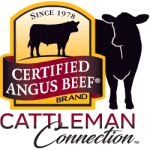 cabcattle.com
cabcattle.com
That's a common myth out in cattle country. To be eligible for our brand, cattle must first pass visual appraisal to qualify as "Angus type." What's that mean, exactly? Each steer or heifer must have a predominantly black hide, with no other color behind the shoulder, above the flanks, or breaking the midline, excluding the tail.
Color is just the first hurdle, as an easy way to start the sort on those that will get railed off for further evaluation. As the hide is removed, these animals are marked with an "A" stamp on the hindquarter or a purple food-grade ink on the hock. They'll still have to pass our 10 carcass specifications that ensures a consistent, high-quality eating experience every time.
[There are some picture examples in the link.]
If you are arguing the "51%" phrasing -- fine -- they would need to be more than 51% black. But holstein or jersey bred to black beef bulls are highly likely to produce steers that would qualify for CAB. At least they sure wouldn't be excluded by hide color -- and I've seen many (lots of dairies and feedlots nearby) and raised a few (one in my feedlot is going to the locker next week -he's all black).
It also specifies lighter muscled carcasses won't qualify. I wonder how many southwestern exotic half bloods that weeds out of the offering."I've heard cattle just have to be 51% black-hided to for cattle to make the CAB brand. Is that true?
FAQs - CAB Cattle
You have questions? We have answers. Find the answers to how cattle achieve CAB and how the brand is funded. Learn what makes CAB so special.cabcattle.com
That's a common myth out in cattle country. To be eligible for our brand, cattle must first pass visual appraisal to qualify as "Angus type." What's that mean, exactly? Each steer or heifer must have a predominantly black hide, with no other color behind the shoulder, above the flanks, or breaking the midline, excluding the tail.
Color is just the first hurdle, as an easy way to start the sort on those that will get railed off for further evaluation. As the hide is removed, these animals are marked with an "A" stamp on the hindquarter or a purple food-grade ink on the hock. They'll still have to pass our 10 carcass specifications that ensures a consistent, high-quality eating experience every time.
[There are some picture examples in the link.]
If you are arguing the "51%" phrasing -- fine -- they would need to be more than 51% black. But holstein or jersey bred to black beef bulls are highly likely to produce steers that would qualify for CAB. At least they sure wouldn't be excluded by hide color -- and I've seen many (lots of dairies and feedlots nearby) and raised a few (one in my feedlot is going to the locker next week -he's all black).
I've been well aware of the program since its inception. It has been a very good marketing ploy by the association.Nope. Read the 10 requirements of the CAB program.
Most feedlots could care less what colour and animal is as long as it has the ability to grow and finish in the shortest time possible. If there is a premium at the end all the better.. They are concerned with profit first and foremost.
In Canada, you can be sold 40 green RFID Certified Angus tags for every REGISTERED Black Angus Bull you own. Red Angus breeders are doing the same. They cost an extra dollar to buy…. 25 years ago I asked the order buyers if the tags were worth buying. I was told if an owners calves came to the ring and they were the right type, all dehorned and castrated properly, brands were applied properly if branded, tags applied correctly….. that likely the owner took pride in his cattle and they would receive a premium regardless.
One told me for performance it was still hard to beat a British x Charolais calf in the lot, if they graded well then so much the better.
The use of AI and ET has produced some very outstanding individuals in all breeds but it looks to have really narrowed to Angus gene pool. Too many chasing numbers instead of real cattle that actually work in their environment .
I really don't think so. The ones that buy in and profit have no reason to leave and are invested in the program. Most will stayImo, what the CAB deal did that is really amazing is they got a large number of people all headed in the same direction. Breed, color, etc... all that aside. They took a notoriously independent group of people and got a large percentage to all move toward the same target, with marketing.
That's why I say, they will either have to adapt or the next group will sure up the loopholes and put them out of business.
I see some of the newbies or the die-hards trying to do it but without the marketing they will not be able to create a large enough market to make a difference without enormous financial back up and for the biggest part, the one that's the first with the most stays the longest and does the best.
Look at other similar markets.
An AQHA horse and an APHA horse of equal ability are put up for sale.
The AQHA horse will almost always sell for more.
The same goes for the stud fees.
The fact is most of the winning paint horses today are primarily a OH with spots, if you cut them open they would look the same without a hide.
The paint could have beaten the QH in open competition
The paint will still generally bring less unless you fid a buyer just bent on having him
We raise some paints, I know what will happen sales price wise
Most of the paints we raise, can, will and do kick most QH's butts but will still bring less
Because I like them I still raise them. it's a personal choice, I don't see them being docked for color, I see it as just the way it is
Not many QH's will beat this little paint horse below in a working cow horse class, but if one even gets close he will sell for more. And his mother was just as good or better, same deal
Attachments
Yep . The "white rule" in AQHA caused some problems for sure. I understand that in the 40's, there was no DNA tests available. back then. There were no tobianos in horse breeds, only ponies .As many ponies were brought over by the Spaniards as there were horses in the 1500's The Chincoteague ponies are a great example. There were, and are, a lot of tobianos in the Mustang herds. So, the white rule was a great way to keep any pony blood out of the AQHA. The bad thing about it, was people classified overos..sabinos and splash whites, as "paints", too. AQHA wouldn;t register them a mistake..., and I think it was not in the best interest of APHA to register them. Then, when that lady about what?...15 years ago?,,,sued AQHA and won,. She said if her horse's had QH DNA on both sides, then even if the white on the knees was a little high, or too much white on the face, a QH x QH = QH. and the judge rightly so, agreed. So, people went about registering thousands of crop outs that were APHA registered as AQHA too. How can a horse be twop breeds? How can a cow be a registered Holstein and a registered Hereford? Or a dog be a registered poodle and a registered English bulldog? Right after that ruling, I heard APHA was going to change to say only one parent could be APHA and AQHA, and the other had to be single registered APHA, to register the foal. Did this ever come about? I know that in APHA, the overos, especially the crop outs, dominated the judged classes....halter and pleasure, but those tobianos like yours dominated the timed event and cattle classes in APHA. Mr. Gunsmoke in the 60's was probably one of thew top five cutting horses ever, But, he sired a lot of crop outs, and NCHA wanted no part of them. This was not true in NRHA, so Gunsmoke became famous as a top sire of reining horses.I really don't think so. The ones that buy in and profit have no reason to leave and are invested in the program. Most will stay
I see some of the newbies or the die-hards trying to do it but without the marketing they will not be able to create a large enough market to make a difference without enormous financial back up and for the biggest part, the one that's the first with the most stays the longest and does the best.
Look at other similar markets.
An AQHA horse and an APHA horse of equal ability are put up for sale.
The AQHA horse will almost always sell for more.
The same goes for the stud fees.
The fact is most of the winning paint horses today are primarily a OH with spots, if you cut them open they would look the same without a hide.
The paint could have beaten the QH in open competition
The paint will still generally bring less unless you fid a buyer just bent on having him
We raise some paints, I know what will happen sales price wise
Most of the paints we raise, can, will and do kick most QH's butts but will still bring less
Because I like them I still raise them. it's a personal choice, I don't see them being docked for color, I see it as just the way it is
Not many QH's will beat this little paint horse below in a working cow horse class, but if one even gets close he will sell for more. And his mother was just as good or better, same deal
In 1980, or whenever CAB was launched, there was no fast easy DNA tests, and the only black beef cattle there was were Angus and Angus crosses, so I see where the 51% black rule came about.
My favorite horse color is a bay with NO white. My favorite paint horse is a tri-colored bay tobiano like yours in the pics. How old is he there?:
Yes, and one can be sure the plants wouldn't stretch things somewhat in order to gain a premium…."I've heard cattle just have to be 51% black-hided to for cattle to make the CAB brand. Is that true?
FAQs - CAB Cattle
You have questions? We have answers. Find the answers to how cattle achieve CAB and how the brand is funded. Learn what makes CAB so special.cabcattle.com
That's a common myth out in cattle country. To be eligible for our brand, cattle must first pass visual appraisal to qualify as "Angus type." What's that mean, exactly? Each steer or heifer must have a predominantly black hide, with no other color behind the shoulder, above the flanks, or breaking the midline, excluding the tail.
Color is just the first hurdle, as an easy way to start the sort on those that will get railed off for further evaluation. As the hide is removed, these animals are marked with an "A" stamp on the hindquarter or a purple food-grade ink on the hock. They'll still have to pass our 10 carcass specifications that ensures a consistent, high-quality eating experience every time.
[There are some picture examples in the link.]
If you are arguing the "51%" phrasing -- fine -- they would need to be more than 51% black. But holstein or jersey bred to black beef bulls are highly likely to produce steers that would qualify for CAB. At least they sure wouldn't be excluded by hide color -- and I've seen many (lots of dairies and feedlots nearby) and raised a few (one in my feedlot is going to the locker next week -he's all black).
simme
Old Dumb Guy
According to a Drovers article on Beef x Dairy calves "A majority of the Angus-sired dairy steers will qualify for CAB on a live basis, and "80% to 95% of the beef-on-dairy crosses will grade Choice or better, with 25% to 45% reaching CAB," Lawrence says."If you are arguing the "51%" phrasing -- fine -- they would need to be more than 51% black. But holstein or jersey bred to black beef bulls are highly likely to produce steers that would qualify for CAB. At least they sure wouldn't be excluded by hide color -- and I've seen many (lots of dairies and feedlots nearby) and raised a few (one in my feedlot is going to the locker next week -he's all black).
Beef X Dairy: Vision & Reality
While dairy producers are rapidly embracing the concept of using beef semen to freshen their cows, the resulting crossbred calves are proving both a valuable opportunity and a challenge for the U.S. beef industry.
At least they are sired by Angus and not Black Simmental, Limo or Herefords, or Brangus and any others that have jumped in to try for a piece of the pie.According to a Drovers article on Beef x Dairy calves "A majority of the Angus-sired dairy steers will qualify for CAB on a live basis, and "80% to 95% of the beef-on-dairy crosses will grade Choice or better, with 25% to 45% reaching CAB," Lawrence says."
Beef X Dairy: Vision & Reality
While dairy producers are rapidly embracing the concept of using beef semen to freshen their cows, the resulting crossbred calves are proving both a valuable opportunity and a challenge for the U.S. beef industry.www.drovers.com
Travlr
Well-known member
According to a Drovers article on Beef x Dairy calves "A majority of the Angus-sired dairy steers will qualify for CAB on a live basis, and "80% to 95% of the beef-on-dairy crosses will grade Choice or better, with 25% to 45% reaching CAB," Lawrence says."
If that's true it's like a stake in the heart of every cattleman that works hard to make their animals the best... and are getting docked because their animals aren't black.
simme
Old Dumb Guy
Did you look at the article? It has a picture and some data on a simangus x holstein. Does not look that bad. Holsteins have very good marbling. An animal that meets the carcass data requirements of CAB is going to be good eating. Cull dairy cows go to slaughter along with true beef cows. What do you see wrong with this steer?If that's true it's like a stake in the heart of every cattleman that works hard to make their animals the best... and are getting docked because their animals aren't black.
Is that steer representative of all dairy x beef? I don't know.
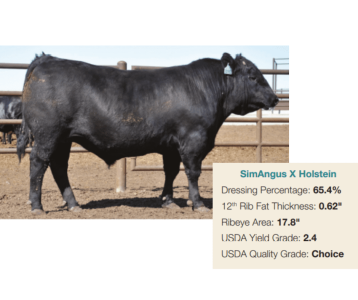
Travlr
Well-known member
I'm not saying that dairy crosses are bad eating or can't marble. Although I've never seen a Jersey that marbled... but then I only have limited experience with Jerseys.Did you look at the article? It has a picture and some data on a simangus x holstein. Does not look that bad. Holsteins have very good marbling. An animal that meets the carcass data requirements of CAB is going to be good eating. Cull dairy cows go to slaughter along with true beef cows. What do you see wrong with this steer?
Is that steer representative of all dairy x beef? I don't know.
View attachment 39162
What I'm saying is that people that put their blood, sweat, and tears into making their cattle as good as they can possibly be are getting docked simply because the animals are the wrong color... while black dairy crosses are getting a premium.
IF it's true.
rocfarm
Well-known member
If there's a $150 dollar bottle of whiskey on this farm, it's because someone else brought it over. Distillers Pride is top shelf around here!
But I average about $2 a can on my beer. Not a big spender there
